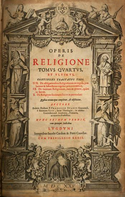Nadere Reformatie: Perbedaan antara revisi
Added {{Uncategorized}} tag (TW) |
|||
| (10 revisi perantara oleh satu pengguna lainnya tidak ditampilkan) | |||
| Baris 1: | Baris 1: | ||
{{Italic title}} |
{{Italic title}} |
||
{{Skolastisisme abad ke-17}} |
|||
{{17th Century Scholasticism}} |
|||
'''''Nadere Reformatie''''' ('''Reformasi Kedua Belanda''' atau '''Reformasi |
'''''Nadere Reformatie''''' ('''Reformasi Kedua Belanda''' atau '''Reformasi Lebih Lanjut'''<ref name="Selderhuis2014">{{cite book|url=https://books.google.com/books?id=O_gxBgAAQBAJ&pg=PA338|title=Handbook of Dutch Church History|publisher=Vandenhoeck & Ruprecht|year=2015|isbn=978-3-525-55787-7|location=Bristol, CT|pages=338–341|chapter=The Further Reformation|editor=Herman Selderhuis|editor-link=Herman Selderhuis}}</ref>) adalah periode dalam sejarah gereja di [[Belanda]] setelah [[Reformasi Protestan]], dari sekitar tahun 1600 hingga 1750. |
||
== |
== Sejarah == |
||
Periode ini dan para tokoh yang mewakilinya dikenal atas keinginan mereka untuk menerapkan prinsip-prinsip Reformasi ke zaman mereka – keluarga mereka, gereja mereka, dan semua sektor masyarakat Belanda pada abad ketujuh belas dan awal abad kedelapan belas. Dalam keseimbangan dan penghargaan mereka terhadap baik ortodoksi maupun kesalehan, ''Nadere Reformatie'' menyerupai [[Puritan|Puritanisme]] di Inggris dan [[Pietisme]] di Jerman.<ref>{{cite book|last=van Lieburg|first=Fred|year=2014|url=https://books.google.com/books?id=P4nPBAAAQBAJ&pg=PP43|title=Calvinism and the Making of the European Mind|location=Leiden|publisher=Brill|isbn=978-90-04-28005-2|pages=43–66|chapter=Dynamics of Dutch Calvinism: Early Modern Programs for Further Reformation}}</ref> |
|||
Bahkan, Puritanisme memiliki pengaruh yang besar terhadap ''Nadere Reformatie''. Banyak tulisan-tulisan Puritan diterjemahkan ke dalam bahasa Belanda selama masa ini. Terlebih lagi, banyak mahasiswa Belanda yang berkunjung mempelajari ide-ide Puritan dari universitas-universitas di Inggris.<ref name="CoffeyLim2008">{{cite book|url=https://books.google.com/books?id=jGcgAwAAQBAJ&pg=PT135|title=The Cambridge Companion to Puritanism|last=Milton|first=Anthony|publisher=Cambridge University Press|year=2008|isbn=978-1-139-82782-9|location=Cambridge|pages=118–119|chapter=Puritanism and the continental Reformed churches|editor=John Coffey|editor2=Paul C. H. Lim}}</ref> |
|||
Dua tokoh terkemuka dari periode ini adalah seorang profesor, [[Gisbertus Voetius]], dan seorang pendeta, [[Wilhelmus à Brakel]]. Karya utama Brakel, ''[[Redelijke Godsdienst]]'', sebuah penjelasan, pembelaan, dan penerapan dari iman Reformed, telah diterjemahkan ke dalam bahasa Inggris.<ref name="À Brakel2015">{{cite book|url=https://books.google.com/books?id=gHYxuQAACAAJ|title=The Christian's Reasonable Service, 4 Vols.|last=À Brakel|first=Wilhemus|publisher=Reformation Heritage Books|year=2015|isbn=978-1-60178-131-4|location=Grand Rapids, MI|translator-last=Elshout|translator-first=Bartel|trans-title=De Redelijke Godsdienst}}</ref> |
|||
== Tokoh penting == |
|||
* [[Jean Taffin]] (1529–1602) |
|||
* [[Willem Teellinck]] (1579–1629) |
|||
* Godefridus Udemans (c.1581-1649) |
|||
* [[Gisbertus Voetius]] (1589–1676) |
|||
* [[Johannes Hoornbeeck]] (1617–1666) |
|||
* [[Andreas Essenius]] (1618–1677) |
|||
* Jodocus van Lodenstein (1620–1677) |
|||
* [[Petrus van Mastricht]] (1630–1706) |
|||
* [[Simon Oomius]] (1630–1706) |
|||
* Jacobus Koelman (1632–1695) |
|||
* [[Wilhelmus à Brakel]] (1635–1711) |
|||
* [[Hermanus Witsius]] (1636–1708) |
|||
* Wilhelmus Schortinghuis (1700–1750) |
|||
== Referensi == |
== Referensi == |
||
{{Reflist}} |
{{Reflist}} |
||
{{Uncategorized|date=Mei 2024}} |
|||
Revisi terkini sejak 2 Mei 2024 03.40
| Bagian dari seri tentang |
| Skolastisisme modern |
|---|
 |
Nadere Reformatie (Reformasi Kedua Belanda atau Reformasi Lebih Lanjut[1]) adalah periode dalam sejarah gereja di Belanda setelah Reformasi Protestan, dari sekitar tahun 1600 hingga 1750.
Sejarah
[sunting | sunting sumber]Periode ini dan para tokoh yang mewakilinya dikenal atas keinginan mereka untuk menerapkan prinsip-prinsip Reformasi ke zaman mereka – keluarga mereka, gereja mereka, dan semua sektor masyarakat Belanda pada abad ketujuh belas dan awal abad kedelapan belas. Dalam keseimbangan dan penghargaan mereka terhadap baik ortodoksi maupun kesalehan, Nadere Reformatie menyerupai Puritanisme di Inggris dan Pietisme di Jerman.[2]
Bahkan, Puritanisme memiliki pengaruh yang besar terhadap Nadere Reformatie. Banyak tulisan-tulisan Puritan diterjemahkan ke dalam bahasa Belanda selama masa ini. Terlebih lagi, banyak mahasiswa Belanda yang berkunjung mempelajari ide-ide Puritan dari universitas-universitas di Inggris.[3]
Dua tokoh terkemuka dari periode ini adalah seorang profesor, Gisbertus Voetius, dan seorang pendeta, Wilhelmus à Brakel. Karya utama Brakel, Redelijke Godsdienst, sebuah penjelasan, pembelaan, dan penerapan dari iman Reformed, telah diterjemahkan ke dalam bahasa Inggris.[4]
Tokoh penting
[sunting | sunting sumber]- Jean Taffin (1529–1602)
- Willem Teellinck (1579–1629)
- Godefridus Udemans (c.1581-1649)
- Gisbertus Voetius (1589–1676)
- Johannes Hoornbeeck (1617–1666)
- Andreas Essenius (1618–1677)
- Jodocus van Lodenstein (1620–1677)
- Petrus van Mastricht (1630–1706)
- Simon Oomius (1630–1706)
- Jacobus Koelman (1632–1695)
- Wilhelmus à Brakel (1635–1711)
- Hermanus Witsius (1636–1708)
- Wilhelmus Schortinghuis (1700–1750)
Referensi
[sunting | sunting sumber]- ^ Herman Selderhuis, ed. (2015). "The Further Reformation". Handbook of Dutch Church History. Bristol, CT: Vandenhoeck & Ruprecht. hlm. 338–341. ISBN 978-3-525-55787-7.
- ^ van Lieburg, Fred (2014). "Dynamics of Dutch Calvinism: Early Modern Programs for Further Reformation". Calvinism and the Making of the European Mind. Leiden: Brill. hlm. 43–66. ISBN 978-90-04-28005-2.
- ^ Milton, Anthony (2008). "Puritanism and the continental Reformed churches". Dalam John Coffey; Paul C. H. Lim. The Cambridge Companion to Puritanism. Cambridge: Cambridge University Press. hlm. 118–119. ISBN 978-1-139-82782-9.
- ^ À Brakel, Wilhemus (2015). The Christian's Reasonable Service, 4 Vols [De Redelijke Godsdienst]. Diterjemahkan oleh Elshout, Bartel. Grand Rapids, MI: Reformation Heritage Books. ISBN 978-1-60178-131-4.
Artikel ini tidak memiliki kategori atau memiliki terlalu sedikit kategori. Bantulah dengan menambahi kategori yang sesuai. Lihat artikel yang sejenis untuk menentukan apa kategori yang sesuai. Tolong bantu Wikipedia untuk menambahkan kategori. Tag ini diberikan pada Mei 2024. |
